Panic bars are one of the most important pieces of hardware in your facilities. They are supposed to keep the bad guys out and they are supposed to let employees and patrons quickly exit in case of emergency. Unfortunately, time and time again, we see makeshift security measures put in place on exit doors that are blatant life safety violations. Because rear doors are often less visible to the general public, they are frequently the primary target for criminals, which means they should be the most secure door of your facility. After having doors pried open either from the side or the bottom, we have consulted with many companies on increasing the security of their exit doors.
There are a number of “solutions” available, but only a handful are code compliant. Some industry professionals recommend using police bars, and while they solve the immediate issue of robbery and theft, unless they are removed during hours of operation, they are also a life safety violation. These bars drastically hinder the ability to exit during an emergency.
Others suggest additional slide bolts and/or deadbolts. Again-unless they are always unlocked when you are open for business – it’s a serious life safety concern and code violation. The most important thing to keep in mind when it comes to rear doors is that they are exit doors; the primary function of the door should be emergency exit. In order to maintain life safety compliance patrons and employees alike must be able to exit (there’s that word again) using one action.
So, what’s the code compliant solution? There are four main security features that comply with life safety code; installing any combination of these will greatly increase the security of your back doors.
- Hinge Side Deadbolts
- Panic Bars – Multi-Point Locking Systems
- Security Hinges
- Astragals and Latch Guards
While you don’t have to use all of these to achieve a high-security door, any combination will go a long way in preventing vandalism. Case in point, take a look at this picture of a recent attempted robbery. This door used a multi-point locking system. While there was damage to the door and frame, the panic bar did its job and kept the would-be robbers out of the facility.
Rear Door Security – Hinge Side Deadbolt
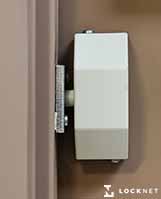 A hinge side deadbolt is an additional piece of hardware installed on the door that secures into a hole cut into the frame. Anywhere from one to three will go a long way in preventing criminals from prying the door open. In the picture to the right, we have just one installed on our exit door. (As an added level of security we also have the Sur-Lock exit device installed.)
A hinge side deadbolt is an additional piece of hardware installed on the door that secures into a hole cut into the frame. Anywhere from one to three will go a long way in preventing criminals from prying the door open. In the picture to the right, we have just one installed on our exit door. (As an added level of security we also have the Sur-Lock exit device installed.)
Rear Door Security – Panic Bars/Multi-Point Locking Systems
By definition, any device (or combination of devices) that secures a door into the opening in multiple places is considered a multi-point locking system. There are two main panic bars that utilize multi-point locking and remain code compliant – the Securitech Trident and the Detex ECL-230X-TBD. While these panic bars are undoubtedly secure, they may fall outside your budget. Adding hinge side deadbolts to any door with an existing panic bar will convert your current device into a multi-point locking system.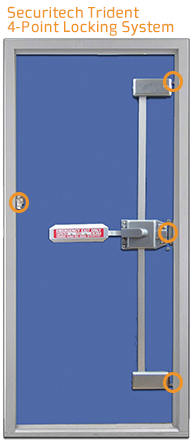
Rear Door Security – Securitech Trident
The Securitech Trident exit device boasts a four-point locking system; a three point panic bar with the addition of a hinge side deadbolt. The device engages into the latch side of the frame in three places, and engages into the hinge side of the frame in one. This device provides a very high level of security. If (and that’s a big if) robbers were able to pry the door open, it would take them a VERY long time – the police would be there long before they were able to enter the location. This video of a staged break-in demonstrates the viability of the Trident.
Rear Door Security – Detex ECL-230X-TBD
The Detex EXL-230X-TBD exit device promotes a three-point locking system that engages into the strike jamb, header, and footer of the opening. A hinge side deadbolt can be added to make it a four-point locking system just as Securitech has done. Much like the Trident, this device is quite tenacious while providing an extremely high level of security. Detex also has a video of a staged break-in to show how their panic bar fairs against door prying.
Rear Door Security – Security Hinges
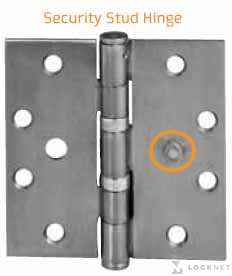 We always recommend security hinges. There are a variety on the market which range from non-removable pin hinges, to hinges with security studs, to a combination of the two. Security stud hinges make it nearly impossible to remove the door from the frame. If a door-savvy criminal were to cut the barrel off the hinge, the hinges would still be locked into each other, effectively preventing removal of the door.
We always recommend security hinges. There are a variety on the market which range from non-removable pin hinges, to hinges with security studs, to a combination of the two. Security stud hinges make it nearly impossible to remove the door from the frame. If a door-savvy criminal were to cut the barrel off the hinge, the hinges would still be locked into each other, effectively preventing removal of the door.
Rear Door Security – Astragals & Latch Guards
Astragals are another great prying deterrent. Often times, criminals attempt to pry the frame from the door to disengage the latch and swing the door open. Astragals cover the space between the frame and the door on the latch side making it very difficult to pry the door open from the latch side. An astragal will provide the most protection against attempted prying; however, latch guards can also be installed that cover only the latch area.
Any combination of these four features will have your back door well on its way to the coveted “Fort Knox” level of security. If you have any questions about what you can do to increase the security of your doors while preserving code compliance, let us know. We’d love to help!

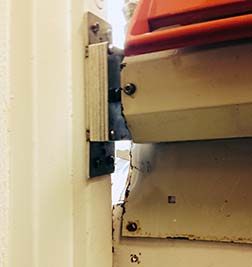
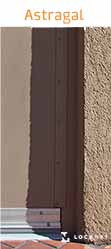
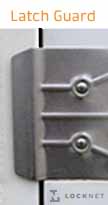
Looking for price and availability in the Toronto Canada Market area